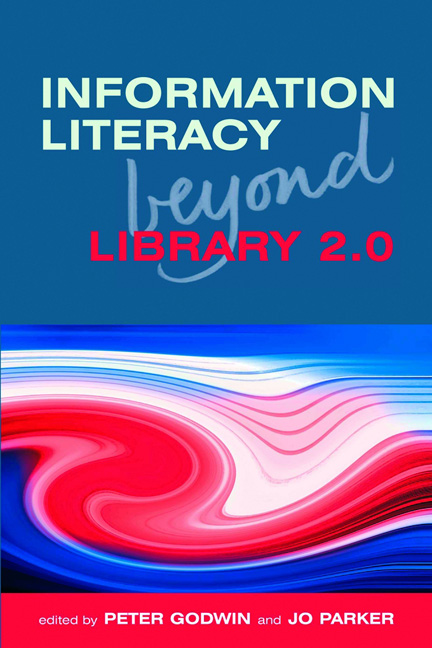Book contents
- Frontmatter
- Contents
- Contributors
- Acknowledgements
- Introduction
- PART 1 RECENT DEVELOPMENTS IN INFORMATION LITERACY AND LIBRARY 2.0
- PART 2 CASE STUDIES
- 7 Reinventing information literacy at UTS Library
- 8 Using games as treatments and creative triggers: a promising strategy for information literacy
- 9 Changing the conversation: introducing information literacy to a generation of smartphone users
- 10 Tweets, texts and trees
- 11 Referencing in a 2.0 world
- 12 Moving information literacy beyond Library 2.0: multimedia, multi-device, point-of-need screencasts via the ANimated Tutorial Sharing Project
- 13 Informed cyberlearning: a case study
- 14 An online course on social media for student librarians: teaching the information skills and literacies of social media
- 15 Transliteracy and teaching what they know
- 16 ANCIL: a new curriculum for information literacy: case study
- 17 TeachMeet: librarians learning from each other
- PART 3 WHAT IT MEANS FOR INFORMATION PROFESSIONALS
- Index
9 - Changing the conversation: introducing information literacy to a generation of smartphone users
from PART 2 - CASE STUDIES
Published online by Cambridge University Press: 09 June 2018
- Frontmatter
- Contents
- Contributors
- Acknowledgements
- Introduction
- PART 1 RECENT DEVELOPMENTS IN INFORMATION LITERACY AND LIBRARY 2.0
- PART 2 CASE STUDIES
- 7 Reinventing information literacy at UTS Library
- 8 Using games as treatments and creative triggers: a promising strategy for information literacy
- 9 Changing the conversation: introducing information literacy to a generation of smartphone users
- 10 Tweets, texts and trees
- 11 Referencing in a 2.0 world
- 12 Moving information literacy beyond Library 2.0: multimedia, multi-device, point-of-need screencasts via the ANimated Tutorial Sharing Project
- 13 Informed cyberlearning: a case study
- 14 An online course on social media for student librarians: teaching the information skills and literacies of social media
- 15 Transliteracy and teaching what they know
- 16 ANCIL: a new curriculum for information literacy: case study
- 17 TeachMeet: librarians learning from each other
- PART 3 WHAT IT MEANS FOR INFORMATION PROFESSIONALS
- Index
Summary
Background
Smartphones, or mobile phones with computer-like capabilities, have rapidly grown in mobile phone market share since the introduction of the Apple iPhone in 2007. To date, librarians’ responses to the growing adoption of smartphones have largely centred on providing mobile access to existing services and resources. The past few years have seen significant increases in libraries offering text messaging reference (e.g. Kohl and Keating, 2009) and building mobile websites or apps (e.g. Bridges, Rempel and Griggs, 2010; Seeholzer and Salem, 2011). Less frequently, however, have librarians considered the effects of smartphones and other mobile devices on students’ achievement of information literacy (IL). Godwin and Parker (2008) and Cvetkovic and Lackie (2009) have presented a variety of discussions about IL for the millennial generation, though none has specifically examined smartphones as an emerging technology. Godwin (2010) focused on using mobile devices to deliver IL instruction. Walsh (2011) compared competency-based models for IL to relational models, finding the relational models more adaptable to mobile information use. A wealth of research addresses mobile search (e.g. Kamvar et al., 2009) and mobile learning (e.g. Kukulska-Hulme and Traxler, 2005; Ally, 2009), though the findings are not often applied to IL instruction. Thus, while librarians acknowledge that patrons increasingly use mobile devices and strive to provide useful services for them, the profession has not yet fully investigated whether and how these new devices change the ways in which users search, find, evaluate, process and use information, particularly information external to library collections. Such research can lead to evidence-based improvements in IL instruction.
Process
My continuing research at the University of Scranton seeks to identify and make explicit the relationships and interactions between smartphones and student IL, with a goal of improving my approach to introductory IL instruction. I began by exploring the functionality and capabilities of the Apple iPhone and various Android smartphones, studying the culture and behaviour these devices enable and seeking to understand how smartphone users engage with information. Using the Association of College and Research Libraries (ACRL) Information Literacy Competency Standards for Higher Education (2000) as a framework, I mapped relationships between expected learning outcomes and smartphone functionality, pinpointing areas in which smartphone use could either help or hinder students’ achievement of IL (Yarmey, 2010).
- Type
- Chapter
- Information
- Information Literacy Beyond Library 2.0 , pp. 103 - 110Publisher: FacetPrint publication year: 2012



